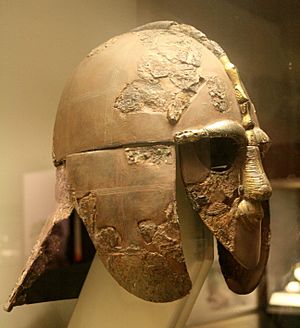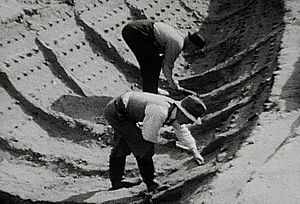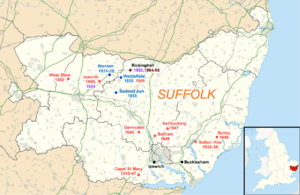Basil Brown facts for kids
Quick facts for kids
Basil Brown
|
|
|---|---|
| Born |
Basil John Wait Brown
22 January 1888 Bucklesham, Suffolk, England
|
| Died | 12 March 1977 (aged 89) Rickinghall, Suffolk, England
|
| Occupation | Archaeologist, astronomer |
| Years active | 1932 to c. 1968 |
| Known for | Excavations at Sutton Hoo |
| Spouse(s) |
Dorothy May Oldfield
(m. 1923) |
Basil John Wait Brown (born January 22, 1888 – died March 12, 1977) was a talented English archaeologist and astronomer. He taught himself many things. In 1939, he found and dug up a 7th-century Anglo-Saxon ship burial at Sutton Hoo. This discovery is known as "one of the most important archaeological finds ever." Even though Basil Brown was often called an "amateur" archaeologist, he worked for a museum for over thirty years. He was a paid expert in digging up ancient sites.
Contents
Early Life and Learning
Basil Brown was born in 1888 in Bucklesham, England. His father was a farmer and a wheelwright. When Basil was very young, his family moved to Church Farm near Rickinghall. From the age of five, Basil loved to study books about stars and space. He got these books from his grandfather.
He went to Rickinghall School and also had some private lessons. Even as a child, he loved to dig in fields. When he was 12, he left school to help on his father's farm.
Basil kept learning on his own. In 1902, he earned a drawing certificate from evening classes. By 1907, he got special diplomas in astronomy, geography, and geology. He studied these through a special mail-order college. He also taught himself Latin and became fluent in French. He even learned some Greek, German, and Spanish.
During World War I, Basil was not fit for war service. But he still volunteered to help the Royal Army Medical Corps. In 1923, Basil married Dorothy May Oldfield. They lived and worked on his father's farm. It was hard to make enough money, partly because Basil spent so much time on his astronomy studies.
By 1934, the farm was not doing well, so Basil gave it up. In 1935, he and May rented a small house in Rickinghall. They lived there for the rest of their lives.
Basil Brown's Work with Stars
On November 27, 1918, Basil Brown joined the British Astronomical Association. This group studies stars and space. He watched the planet Mercury pass in front of the sun in 1924. That same year, he wrote articles about mapping stars for a science magazine.
In 1932, Basil published a book called Astronomical Atlases, Maps and Charts. He had been working on it since 1928. This book was very popular and was even printed again in 1968. He also studied meteors, the aurora (Northern Lights), and the zodiacal light for the British Astronomical Association. However, in 1934, he had to stop being a member because he didn't have enough money.
Starting His Archaeology Career
In his free time, Basil kept exploring the countryside. He looked for old Roman remains. He was very interested in how ancient sites were lined up. He used a compass and measurements to find eight medieval buildings. He also found Roman settlements and old roads.
In 1934, he found Roman pottery workshops. This led to him digging up a Roman kiln (a type of oven) in 1935. He successfully moved it to the Ipswich Museum. This is how he met Guy Maynard, the museum's curator. Basil asked Maynard if he could work for the museum.
His first job with the museum was for thirteen weeks in 1935. He earned £2 (about $2.50 USD today) a week. He found a Roman villa at a place called Stanton Chare. This led to more digging work for three seasons, from 1936 to 1938. This archaeological work gave him some regular money. But it was less than the minimum wage for farm work. So, he also had to keep working as an insurance agent. He even joined the police as a special constable (a volunteer police officer).
The Amazing Sutton Hoo Discoveries

Edith Pretty (1883–1942) owned a large estate called Sutton Hoo in Suffolk. She was curious about the eighteen ancient mounds on her land. In 1937, she talked to a local history expert about opening them. This led to Guy Maynard, the Ipswich Museum curator, offering Basil Brown's help.
The name Sutton Hoo comes from "Sutton," meaning "south farm," and "Hoo," meaning a "hill" or "elevated place." This often meant a burial site. Maps have shown the farm and its mounds since at least 1601.
Digging in 1938
Basil Brown started working for Mrs. Pretty in June 1938. He was paid 30 shillings a week. He stayed at Mrs. Pretty's chauffeur's house. He brought many books about ancient times and digging reports. He had only two weeks to start, so he used a quick digging method.
With the help of Mrs. Pretty's workers, Basil dug into three mounds. He found that they were burial sites. But they had been robbed in the medieval period.
Basil first dug into what was called Mound 3. He found a "grave deposit" with early Saxon pottery. He also found an iron axe. Mrs. Pretty then decided to open other mounds.
Next, Basil worked on Mound 2. He found a ship's rivet (a metal fastener). He also found pieces of Bronze Age pottery. On July 11, he found more rivets. He asked the Ipswich Museum for information about another ship burial found at Snape. Basil visited the Aldeburgh Museum to see the Snape artifacts. He saw that the Sutton Hoo rivets were very similar. Back at Sutton Hoo, he uncovered the shape of a boat. It seemed to have been cut in half. There were signs of a cremation (burning of a body). He also found a gold-plated shield boss (the center part of a shield) and glass pieces.
Basil also dug into Mound 4. He found that robbers had completely emptied it.
In August 1938, Basil went back to work for the Ipswich Museum.
Digging in 1939
Basil returned to Sutton Hoo in May 1939. He started digging into Mound 1, the largest mound. He was helped by Mrs. Pretty's gardener and gamekeeper.
On May 11, he found iron rivets that were bigger than those from Mound 2. This meant an even larger ship was buried there. Basil rode his bike to Ipswich to tell Guy Maynard. Maynard told him to be very careful. Basil uncovered the shape of a 27-meter-long ship from the 7th century AD. He also found signs that robbers had stopped before reaching the main burial.
Basil and Maynard realized this was a huge find. Maynard told Mrs. Pretty that they should get the British Museum involved. Mrs. Pretty was worried the digging would stop for a long time. But neither Basil nor Maynard wanted to continue without more expert help.
Charles Phillips, an archaeologist from Cambridge University, heard about the dig. He visited the site on June 6. Phillips suggested calling the British Museum and the Ministry of Works.
A meeting was held at Sutton Hoo three days later. Phillips was given control over the excavations. Basil Brown was allowed to continue working. On June 14, he uncovered the burial chamber. Later, he found the ship's stern (back end). In 1940, experts thought the burial site might belong to Rædwald of East Anglia, an ancient king.
Phillips took charge of the main digging on July 11. He brought in a team of other archaeologists. On July 21, one of them found the first signs of what would become 263 amazing items. The press learned about the important find by July 28.
Basil Brown continued to work on the site. He followed his contract with Mrs. Pretty. But he was not allowed to dig inside the burial chamber he had found.
On August 14, Basil testified at a special hearing. It was decided that the treasures belonged to Mrs. Pretty. The finds were moved to London for safekeeping because of the threat of war. Basil and a farm worker carefully covered the excavated ship site.
Basil returned to his other archaeological work in late 1939.
After Sutton Hoo
During World War II, Basil Brown did some archaeology for the Ipswich Museum. But he mainly worked in civil defense in Suffolk. He helped with the Royal Observer Corps.
After the war, Basil worked for the Ipswich Museum again. He was called an "attendant" but mostly did archaeology outside the museum. He joined local history and astronomy groups. In 1952, he dug in Rickinghall. He found an old chapel and a Norman font (a basin for baptisms).
Until the 1960s, he continued to study ancient remains in Suffolk. He rode his bike everywhere. He kept very detailed notebooks with photos, plans, and drawings. In 1961, Basil retired from the Ipswich Museum. But he kept digging at Broom Hills in Rickinghall from 1964 to 1968. He found proof of Stone Age people, Roman occupation, and a Saxon nobleman's house.
Later Life and Legacy
In 1965, Basil Brown had a stroke or heart attack. This stopped his active archaeological work. He died on March 12, 1977, from pneumonia at his home in Rickinghall.
People respected Basil Brown very much. The Suffolk Institute worked to get him a pension (regular payments after retirement). In 1966, he was given a special pension of £250. Basil never published books about his archaeological work by himself. But his careful notebooks are now kept by the Suffolk County Council. These notes helped create the County Sites and Monuments Record for Suffolk.
Basil encouraged children to work on his dig sites. He taught a whole generation of young people about archaeology. He showed them the exciting things hidden under the fields.
In 2009, a plaque was put up in Rickinghall Inferior Church to honor Basil Brown. This shows how much local archaeologists, historians, and people respected him. The items found at Sutton Hoo are still studied today. Scientists use new methods to learn even more about them. The Sutton Hoo Society holds an annual Basil Brown Memorial Lecture in his name. A street in Rickinghall, where he lived, is named Basil Brown Close.
Basil Brown was a main character in the 2021 film The Dig. The movie told the story of the amazing Sutton Hoo discoveries. Actor Ralph Fiennes played Basil Brown.
See also
 In Spanish: Basil Brown para niños
In Spanish: Basil Brown para niños



